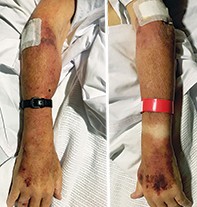A rash on the forearms of a hospitalised patient
Test your diagnostic skills in our regular dermatology quiz. What is the cause of the erythematous, hot and itchy rash on this man’s forearms?
Case presentation
A 70-year-old man presents to hospital with peripheral lower leg oedema. He has metastatic pancreatic carcinoma and recently completed his first round of chemotherapy.
On admission, the patient is given an immediate dose of hydrochlorothiazide 100mg. Three days later he is noted to have a rash on his forearms that evolves into hyperpigmentation (Figure 1). The rash is erythematous, hot and itchy and associated with mild oedema. It has a sharp cut-off at the edge of his pyjama sleeve and the skin under his watch is spared.
Differential diagnoses
Conditions to consider among the differential diagnoses include the following.
- Sunburn. The distribution of the rash indicates that light exposure is probably implicated in this reaction, and the reaction does appear like a sunburn. However, the patient had not left the ward. This is not the correct diagnosis.
- Allergic contact dermatitis. If an allergen (e.g. a skin lotion or cream) is applied topically to a large area, the typical erythema evident in an allergic contact reaction will occur over the same large area. The erythema, sometimes with bullae and vesicles, is always distributed where the allergen was applied. Allergic contact dermatitis presents acutely. It is an important differential diagnosis in this presentation, but the patient had no history of applying any new topical agents to his forearms.
- Drug allergy. The timeline associating the intake of a new ;drug (hydrochlorothiazide) with the skin eruption suggest that the drug could be involved in some way. The most common cutaneous manifestation of a drug allergy is delayed-type hypersensitivity. It presents as a widely distributed exanthematous (morbilliform or maculopapular) eruption about seven days after commencing the drug (Figure 2); the onset may be quicker if there is a history of prior exposure. Drug allergy can also manifest as urticaria with or without angioedema. Wheals can occur anywhere on the body, minutes to days after ingestion depending on prior exposure. This is not the diagnosis in this patient’s case, and his rash is not characteristic of an exanthem or wheals.
- Phototoxic drug reaction. This is the correct diagnosis. Phototoxic drug reactions are relatively common. They occur when sufficient amounts of certain medications interact with ultraviolet light on the skin, which results in an unstable molecule that causes direct cell damage.1 If a large dose of drug has been taken only a minimal amount of ultraviolet light is required – in this patient’s case, ambient light in the hospital was sufficient to cause the reaction after the single dose of hydrochlorothiazide. The damage manifests as an exaggerated sunburn – erythema, oedema and, potentially, bullae formation, followed by hyperpigmentation. The medications implicated in phototoxic drug reactions have similar molecular structure and may be topical or systemic agents. Common photosensitising medication groups are thiazide diuretics, antibiotics (especially doxycycline), NSAIDs, retinoids and antipsychotics. Some medications are designed to utilise photosensitivity, such as topical 5-aminolevulinic acid for the management of actinic keratoses.
Diagnosis
Phototoxic drug eruptions are diagnosed clinically on the basis of a history of a precipitating agent, ultraviolet light exposure and a characteristic rash over only light-exposed areas.
Management
The most important step in the management of phototoxic drug eruptions is to identify the causative agent. Once this has been established, the decision to cease the drug must be weighed against the therapeutic aims and benefit. Medications with short half-lives should be given at night. Patients being commenced on potential phototoxic medications should be educated regarding sun protection, including sunscreens that block both UVA and UVB rays. No specific treatment is needed and the rash will resolve spontaneously. MT

